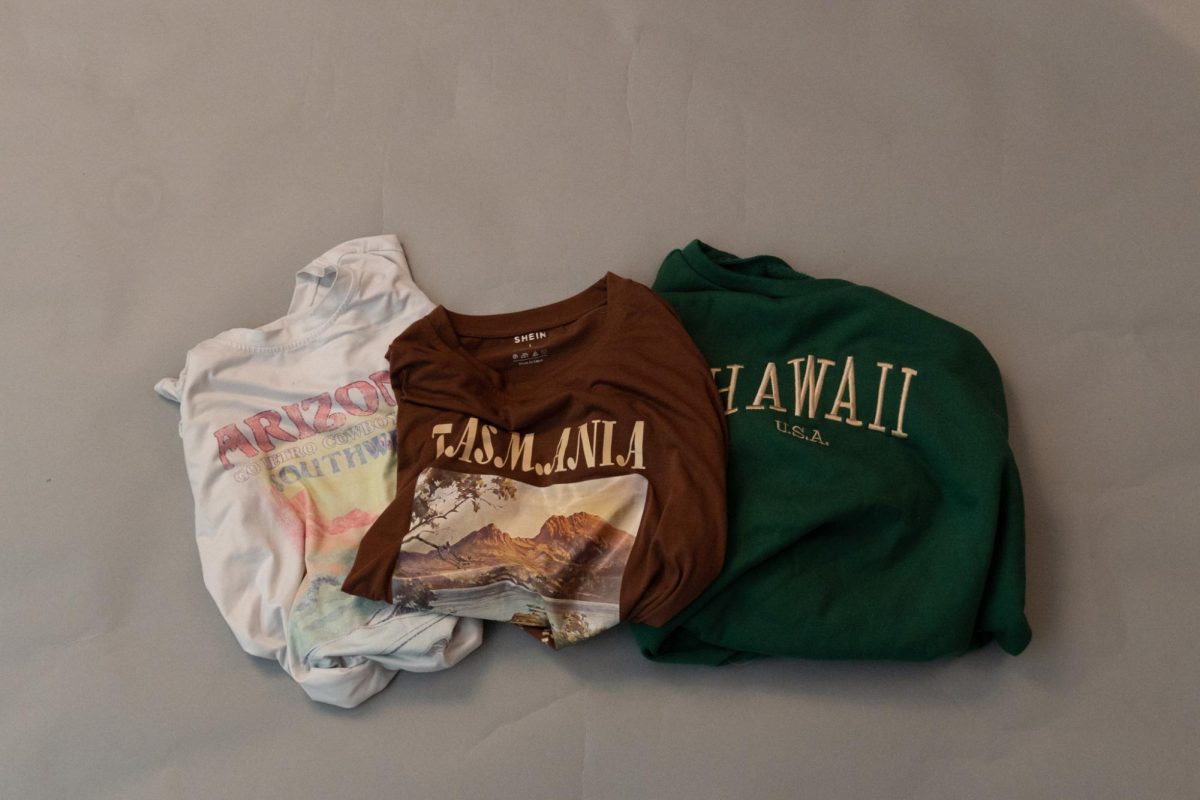Shein’s “BAE Ladies’ Floral Printed Crop Top And Skirt Set For Summer Holiday” is 53 percent off, priced at $5.80. It is incredibly cheap, but in three weeks, it’ll end up in a landfill.
Fast fashion is low-end, trendy clothing that samples styles from fashion shows, social media, and celebrity culture. According to Sustainably Chic, Shein, Temu, and Zara are the three most well-known brands – the ones that we should avoid buying from because of the environmental consequences even though they tend to be more affordable compared to high-end fashion brands.
According to a report by Rest of World, a nonprofit publication, Shein added between 2,000 and 10,000 individual items to its app every day between July and Dec. of 2021. The endless stream of new clothing options on websites reels in consumers to keep buying more, encouraging a cycle of overconsumption and waste as the out-of-style items are frequently discarded to make room for new ones.
Fast fashion is a large contributor to the decline of our ecosystem. The average U.S. consumer throws away 81.5 pounds of clothing every year, which is equivalent to 2,150 pieces per second, according to Earth, an “environmental news website dedicated to providing comprehensive coverage of crucial issues affecting our planet.”
Over the past 20 years, the fast fashion industry has grown at a rapid rate — global consumption has increased by 400 percent, as found by Biological Diversity. This industry is huge and influential, contributing heavily to our climate crisis. According to Princeton University, it takes 10,000 liters of water to produce one kilogram of cotton or approximately 3,000 liters of water for one cotton shirt. Around 20 percent of our world’s wastewater is connected to producing clothes.
The Columbia Climate School states that 93 million metric tons of clean water are consumed annually by fast fashion, which is half of what Americans drink a year. For example, cotton is one of the main crops being used in fast fashion. One kilogram of cotton used to produce a pair of jeans can consume 7,500 to 10,000 liters of water — the amount a person drinks over 10 years.
In addition to how much water the fast fashion industry consumes, the fabrics they use are also a problem. Shein’s main synthetic materials are polyester and lycra. Additionally, Temu uses synthetic fabrics for cheap clothing that are derived from petroleum, a fossil fuel.
According to a “project by design undergraduate students at the University of California, Davis – Department of Design” called Design Life-Cycle, polyester is one of the most popular fabrics due to its cheap and resilient nature. The process to manufacture this fiber has been known to create many toxic wastes and emissions. Polyester garments accumulate in landfills because conventional polyethylene terephthalate (PET) is not biodegradable according to the National Library of Medicine.
Synthetic materials are one of the main issues contributing to our ecosystem. According to Princeton, approximately 35 percent of all microplastics are from synthetic materials. Fibers that are made up of polyester (consisting of plastic) release even more carbon emissions into the atmosphere. Plastic is difficult to break down in the ocean — it takes years after years to do so, breaking off into hundreds of microplastics. When plastic finally breaks down, it becomes a toxic substance that negatively affects the marine ecosystem.
As of 2024, Shein is valued at around $68 billion, a significant loss compared to 2023 ($100 Billion to $68 Billion) due to a decline in venture funding across the fast fashion sector. In addition, Shein has been exposed for their violation of human rights. According to Time, advocacy groups and journalists uncovered evidence that Shein’s $11 bikinis and $7 crop tops were being made by people working in unsafe workshops, lacking safety protocols like windows and emergency exits.
The quick rise of the fast fashion industry has significantly contributed to the climate crisis by increasing water consumption, using toxic fabrics that harm our environment, and encouraging overconsumption. As consumers buy and discard clothing at a fast rate, vast amounts of toxic fabrics pile up in landfills, releasing harmful chemicals and contributing to environmental degradation, worsening the climate crisis.
Fast Fashion off-limits here!
As most TikTok users know, trend cycles are in and out at an eye-popping rate. The “2020” aesthetic is inspired by the nostalgia of past aesthetics and trends. For example, bucket hats were inspired by the early 2000s’ Y2K style, an accessory for nostalgic streetwear and casual outfits.
Fast fashion can be traced back to the 1960s and 1970s when mass production and consumer culture grew. Fast fashion truly became a dominant force in the fashion industry due to quick manufacturing, globalization, and cheap, trendy clothing. However, as fast fashion has grown even more rampant and the pace at which clothes can be produced has accelerated, fast fashion trend cycles have shortened.
The Michigan Daily states that the lifecycle of fashion trends include five steps: introduction, rise, peak, decline, and obsolescence. These trend cycles used to last around 20 years but now it has shrunk down to five to 10 years. Social media plays a significant role in why the globalization of fast fashion trends start and end faster. It also rapidly changes fashion trends and influences more consumption.
On Shein and Temu, you can buy a “dupe,” a cheap duplicate of a brand or style that is currently trending at a lower price compared to the original. Social media created a vital impact on fast fashion brands; it has significantly changed how younger generations think about clothing consumption. Social media’s influence on fast fashion results in overconsumption, environmental degradation, and exploitation of labor, all while promoting unrealistic consumerism.
With social media platforms like TikTok and Instagram promoting fast fashion or putting these trends on our algorithms, it adds “FOMO” (Fear Of Missing Out) on new trends that you will see around stores within a matter of days. Influencers are constantly promoting fast fashion along with following microtrends to stay relevant, so they do hauls with cheap clothing from fast fashion stores, which creates a lot of waste and overconsumption.
While fast fashion offers affordability and accessibility, its environmental and social costs outweigh the benefits. From polluting our waters to an unnecessary pile of last year’s clothes sitting in the corner of your room, we need to be more aware of fast fashion’s negative impacts. So even though fast fashion might be on trend, it is plummeting off the charts when it comes to quality.






























































![[SATIRE] Spirit Week: Written in the Stars](https://www.themuseatdreyfoos.com/wp-content/uploads/2024/03/front.png)
